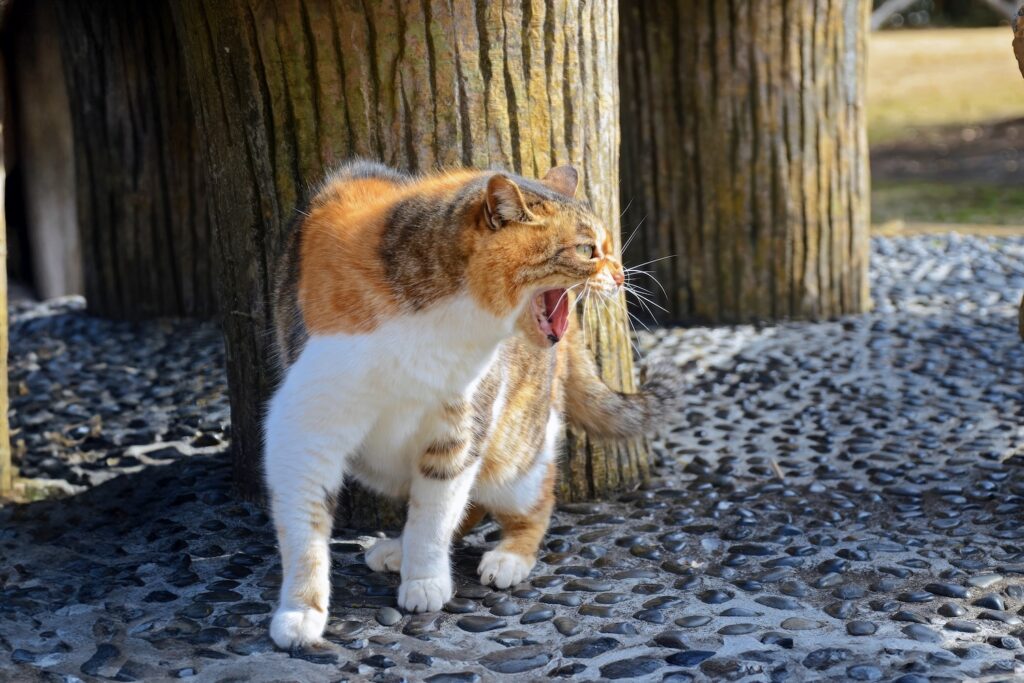Unraveling Feline Aggression: Understanding the Causes and Managing the Behaviour
 maturika/Pixabay.com
maturika/Pixabay.com Aggression is a broad term. In a cat it ranges from hissing and growling, up to a full blown attack. However this description doesn’t tell us anything about what is motivating the cat to show aggression. In most cases cats prefer to avoid conflict but, if aroused sufficiently, things can escalate and they can cause some very nasty injuries.
Causes of Feline Aggression
- Fear – This is the most common motivator in all species. This is a natural defensive behaviour, directed at a real or perceived threat.
- Territorial aggression – Because cats are solitary species they do not tolerate sharing their territory with cats outside their social group. This can include cats outside as well as those that share the same home, especially those that they have not grown up with.
- Re-directed aggression – This type of aggression can be directed to owners. It occurs when a cat cannot reach the target of its aggression and instead turns on to the closest, most accessible target. A good example is if a resident cat sees an unfamiliar cat in its garden and begins to feel angry, it may turn on its housemate. These types of attack can be very unsettling for previously well bonded cats.
- Play aggression – This can be more common in poorly socialised cats, particularly if they have not interacted with litter mates. These cats use lots of predatory behaviours and pounce on moving targets – usually owners’ legs!
- Low threshold for petting – Many cats dislike too much petting especially in sensitive areas such as the belly. Some seem to have a low threshold for physical attention so a hands off approach is best. Most cats prefer petting to be of a short duration and focused around the head.
- Predatory aggression – This is similar to play aggression – the predatory drive is high in these individuals.
- Maternal aggression – This natural behaviour is motivated by a queen protecting her off-spring.
What are the Signs?
- Body stiffening
- Dilated pupils (a wide staring pupil)
- Vocalisation – hissing, spitting and growling
- Tail twitching/swishing
- Changes to the position of the ears
Practical Solutions and Tips
- Do not handle your cat – No matter what the cause of aggression, it is important not to handle your cat whilst it is showing signs of feeling angry or stressed
- Never try and physically break up a cat fight – you run the risk of getting some very nasty injuries
- Know what the signs of aggression are to avoid injuries and prevent escalation
- Do not use punishment – This is counter-productive. Cats will only get more emotionally aroused and bonds can be broken.
- If safe to do so, use mild distraction techniques. For example rolling a ball with a bell across the room can divert a cat from pouncing on your legs before you move
- Identify the underlying motivation for the aggression
- Avoid triggers for aggression – e.g. separate squabbling cats, use blinds and curtains to block your cat seeing intruders
- Avoid using hands for any physical play
- Provide ample environmental enrichment as this has been shown to help reduce stress and re-directs certain types of aggression
- Seek the help of a suitably qualified feline behaviour counsellor
Recommended Products
Narrow and wide tubes — Stable base with sloped surface
Describing feline behavior from both a mechanistic and functional approach, this textbook provides an accessible overview of this fascinating subject. The book begins by addressing physiological, developmental and psychological aspects, with chapters on domestication, the development of the senses, learning, communication and feeding behavior. The authors then build on this foundation to discuss social behavior, hunting and predation, cat-human interactions and welfare. Fully updated throughout, this new edition also includes two new chapters on behavioral disorders due to pathologies and from misdirected natural behavior. It is the essential source of cat behavior information.
Want to learn more?
Here’s a selection of our courses which may help with with feline fear, anxiety and aggression:





